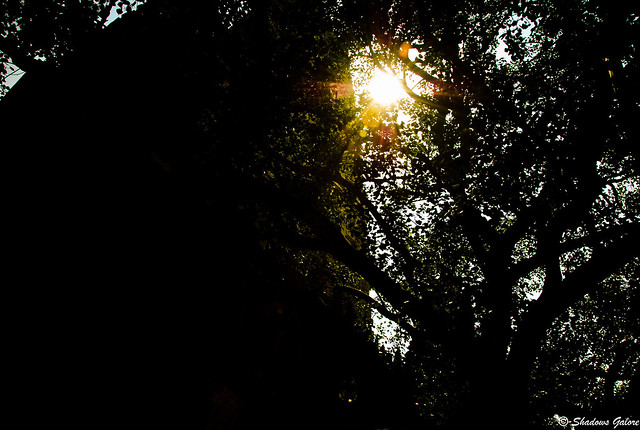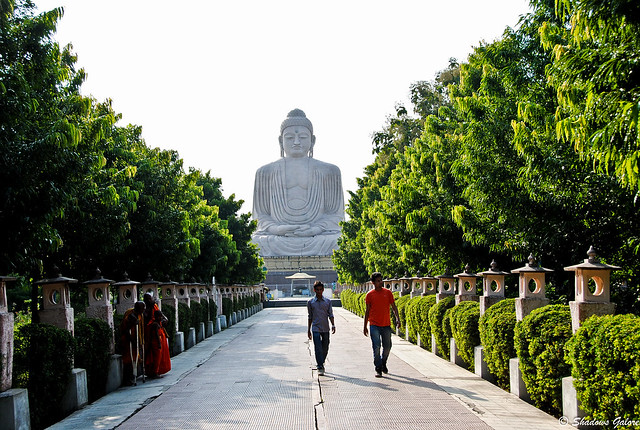When I went home this Durga Puja, I had a clear purpose in mind, to somehow see Bodh Gaya. I know it’s a shame that I hadn’t been to Bodh Gaya in spite of being a Bihari, but when I grew up there, the socio-political conditions were not very fit for tourism. This time, however, it had to be done. So the day I arrived in Patna, we decided that we will be making a family0 trip to the place. So early next day, we were off to trace the first footsteps of Buddha.
Sometime in 500 BC, Prince Siddharta, wandering in the search of truth, reached the banks of the Falgu River in Gaya. It was there that he sat in meditation for three days and on the third day, attained enlightenment and became Gautam Buddha. He then spent seven weeks in the surrounding places meditating and introspecting before leaving to Sarnath to give his first sermon. This trip to Bodh Gaya was my attempt to trace the first steps of Buddha.
There are rail and road routes to Bodh Gaya and we chose the latter. As we came out of Patna we found that the region was flooded by the river waters which devastate Bihar every year. The highway started looking like a single long train dividing the sea. However, the conditions improved as we neared Gaya, our first destination.
%22%20transform%3D%22translate(1.3%201.3)%20scale(2.65625)%22%20fill-opacity%3D%22.5%22%3E%3Cellipse%20fill%3D%22%23fff%22%20rx%3D%221%22%20ry%3D%221%22%20transform%3D%22matrix(-1.80318%20-39.70911%20254.7375%20-11.56756%20100.6%2018.9)%22%2F%3E%3Cellipse%20rx%3D%221%22%20ry%3D%221%22%20transform%3D%22matrix(-2.90093%20-48.82822%20147.56818%20-8.76717%20129.2%20116.1)%22%2F%3E%3Cellipse%20fill%3D%22%23fff%22%20rx%3D%221%22%20ry%3D%221%22%20transform%3D%22matrix(20.85784%20-26.32046%2081.19576%2064.34419%20220.2%2014)%22%2F%3E%3Cellipse%20fill%3D%22%23fff%22%20cx%3D%2227%22%20cy%3D%228%22%20rx%3D%2287%22%20ry%3D%2262%22%2F%3E%3C%2Fg%3E%3C%2Fsvg%3E) |
| Vishnupad Temple, Gaya |
Situated at the banks of river Falgu, Gaya is the second largest city in Bihar and an ancient abode of civilization. Very near to Gaya are the Barabar caves, the oldest in the country. Gaya is famous as a pilgrimage centre for the Hindus who come here to perform the “Pinda daan” of their near and dear ones who have passed away in the hope that this will fetch them salvation. Our first stop at Gaya was the Vishnupad temple, said to have the foot imprints of Lord Vishnu himself. The temple is an ancient one, however, the present structure was built by Devi Ahalyabai Holkar of Indore after the original temple was destroyed by foreign invaders. From the temple, we reached the bank of river Falgu, said to have been rendered dry by a curse of Sita. On the other side of the river, we could see a hillock called Pret Shila (Ghost rock) where the Pinda daan happens and a temple built over it.
%27%20fill-opacity%3D%27.5%27%3E%3Cellipse%20fill%3D%22%23fff%22%20fill-opacity%3D%22.5%22%20rx%3D%221%22%20ry%3D%221%22%20transform%3D%22rotate(4%20182.5%205736)%20scale(569.90525%20150.90831)%22%2F%3E%3Cellipse%20fill%3D%22%234b4b4b%22%20fill-opacity%3D%22.5%22%20rx%3D%221%22%20ry%3D%221%22%20transform%3D%22matrix(-534.19167%20-59.47218%2013.7143%20-123.18476%20237%20294.2)%22%2F%3E%3Cellipse%20fill%3D%22%234d4d4d%22%20fill-opacity%3D%22.5%22%20rx%3D%221%22%20ry%3D%221%22%20transform%3D%22matrix(288.45133%2011.67398%20-1.48948%2036.80354%20132.7%20240)%22%2F%3E%3Cpath%20fill%3D%22%23e9e9e9%22%20fill-opacity%3D%22.5%22%20d%3D%22M678.7-41.2L-41.2%204l762.4%20207.2z%22%2F%3E%3C%2Fg%3E%3C%2Fsvg%3E) |
| Pret Shila and Ram Shila across Falgu |
One interesting thing about Gaya is the Pandas (priests) of Gaya. If you are anyone worth noticing in India, there will be a priest in Gaya who will claim to be your family priest. Give him your place of residence and a few details and he will surprise you with your complete ancestral tree going back to centuries. Only God knows how they have managed to keep this database intact and updated through centuries of turmoil.
%27%20fill-opacity%3D%27.5%27%3E%3Cellipse%20fill%3D%22%232e3000%22%20fill-opacity%3D%22.5%22%20rx%3D%221%22%20ry%3D%221%22%20transform%3D%22matrix(-129.91555%20-26.92104%2026.12561%20-126.07697%20620.5%20264.8)%22%2F%3E%3Cellipse%20fill%3D%22%23abc8ed%22%20fill-opacity%3D%22.5%22%20rx%3D%221%22%20ry%3D%221%22%20transform%3D%22matrix(-24.3406%20-143.91022%20658.54207%20-111.38405%20358.3%201.4)%22%2F%3E%3Cellipse%20fill%3D%22%2340262a%22%20fill-opacity%3D%22.5%22%20rx%3D%221%22%20ry%3D%221%22%20transform%3D%22matrix(13.47663%20-82.54921%20236.22282%2038.56471%2041.2%20292.7)%22%2F%3E%3Cellipse%20fill%3D%22%237b8714%22%20fill-opacity%3D%22.5%22%20rx%3D%221%22%20ry%3D%221%22%20transform%3D%22matrix(-137.94647%2023.41849%20-13.51152%20-79.58953%20517.2%20346)%22%2F%3E%3C%2Fg%3E%3C%2Fsvg%3E) |
| Mahabodhi Temple |
After the brief stoppage at Gaya, we went to Bodh Gaya which is about 17 KM away. This small town is a world in itself, a melting pot of different ideologies of Buddhism from all over the world. Here you can find beautiful Buddhist monuments, monasteries and temples from across countries in Asia, people from different nationalities, monks, tourists and a few locals who run a subsistence economy customized to suit the visitors.
%27%20fill-opacity%3D%27.5%27%3E%3Cellipse%20fill%3D%22%23686966%22%20fill-opacity%3D%22.5%22%20rx%3D%221%22%20ry%3D%221%22%20transform%3D%22rotate(-165.5%20214.2%20-.2)%20scale(86.4962%20113.85882)%22%2F%3E%3Cellipse%20fill-opacity%3D%22.5%22%20rx%3D%221%22%20ry%3D%221%22%20transform%3D%22matrix(306.53388%20604.01286%20-174.61572%2088.61671%20157.3%20295.9)%22%2F%3E%3Cellipse%20fill%3D%22%23323232%22%20fill-opacity%3D%22.5%22%20rx%3D%221%22%20ry%3D%221%22%20transform%3D%22rotate(-63.8%20329%20-312.6)%20scale(135.95169%20202.53577)%22%2F%3E%3Cellipse%20fill-opacity%3D%22.5%22%20rx%3D%221%22%20ry%3D%221%22%20transform%3D%22rotate(92%2076.4%20378.6)%20scale(58.61144%20154.78528)%22%2F%3E%3C%2Fg%3E%3C%2Fsvg%3E) |
| In the shade of the Bodhi Tree |
The first place we visited in Bodh Gaya was the Mahabodhi temple. This temple, originally built by Emperor Ashoka around 2500 years back is the most important site of Buddhism. It was here under the Bodhi tree that Buddha attained enlightenment. The Bodhi tree situated at the back of the temple is of the 5th generation, created from a sapling taken from the Bodhi Tree in Srilanka which in turn, was a sapling taken from the preceding Bodhi tree in India. The temple is plain and beautiful. My advice: Do not hurry. Sit there in the shade of the Bodhi tree for some time with eyes closed and let the surroundings engulf you with their magic. Soak in the energy which still flows in the place, and let pure white peace calm down your nerves. It’s difficult to explain in words what it was, but it was something!
%27%20fill-opacity%3D%27.5%27%3E%3Cellipse%20fill%3D%22%23fff%22%20fill-opacity%3D%22.5%22%20rx%3D%221%22%20ry%3D%221%22%20transform%3D%22rotate(2.3%20-535.1%209921.8)%20scale(677.34375%20111.48466)%22%2F%3E%3Cellipse%20fill%3D%22%231b2003%22%20fill-opacity%3D%22.5%22%20rx%3D%221%22%20ry%3D%221%22%20transform%3D%22matrix(-399.60974%20-18.02098%208.46879%20-187.79285%20350.3%20349.3)%22%2F%3E%3Cpath%20fill%3D%22%23fff%22%20fill-opacity%3D%22.5%22%20d%3D%22M17.3-41.2L721.2%2012-41.2%20176.6z%22%2F%3E%3Cellipse%20fill%3D%22%23fff%22%20fill-opacity%3D%22.5%22%20rx%3D%221%22%20ry%3D%221%22%20transform%3D%22matrix(-159.53298%20-66.08072%2037.63343%20-90.85513%20605.3%2083.8)%22%2F%3E%3C%2Fg%3E%3C%2Fsvg%3E) |
| The Thai Temple |
Well, after the visit to the Mahabodhi temple, it was time to visit the various Buddhist temples and monasteries built by different nations in the vicinity. We visited temples from Srilanka, Tibet, Vietnam, China, Burma, Bangladesh, Thailand, Cambodia, Bhutan and Japan, each monument unique in architecture and feels like something from another world. This is what makes Bodh Gaya what it is. Particularly beautiful were the temples from Thailand and Bhutan, look at the pictures and you will know what I am saying.
%22%20transform%3D%22translate(1.3%201.3)%20scale(2.65625)%22%20fill-opacity%3D%22.5%22%3E%3Cellipse%20fill%3D%22%23fff%22%20cx%3D%2235%22%20cy%3D%22116%22%20rx%3D%2244%22%20ry%3D%2230%22%2F%3E%3Cellipse%20cx%3D%228%22%20cy%3D%2224%22%20rx%3D%2251%22%20ry%3D%2251%22%2F%3E%3Cellipse%20fill%3D%22%23f1e9ed%22%20rx%3D%221%22%20ry%3D%221%22%20transform%3D%22matrix(5.9061%20-29.55718%2052.22417%2010.43542%20214.1%20129)%22%2F%3E%3Cellipse%20fill%3D%22%2320181c%22%20rx%3D%221%22%20ry%3D%221%22%20transform%3D%22matrix(29.6067%20-40.64149%2024.70905%2018.00016%20127%2097.1)%22%2F%3E%3C%2Fg%3E%3C%2Fsvg%3E) |
| A pilgrim from .. err .. somewhere |
For lunch, there are not many options if you are looking for Indian food. It will be easy for you to find Chinese, Thai or Tibetan food but difficult to find a decent 4-course Indian meal in this place. However, we were fortunate to find a good restaurant named F3 located just opposite to the Museum. The food was fabulous and it’s a Thumbs Up from my side. Post lunch, we had coffee in a cafeteria called Be Happy Cafe. It was more like a Goan shack, run by a foreigner and a coffee, albeit a little pricey, was good. There are other cafés called Cafe Om and the Bowl of Compassion Cafe but we could not find them.
%27%20fill-opacity%3D%27.5%27%3E%3Cellipse%20fill%3D%22%23fff%22%20fill-opacity%3D%22.5%22%20rx%3D%221%22%20ry%3D%221%22%20transform%3D%22rotate(83.4%20138.8%20167.8)%20scale(133.69527%20218.15957)%22%2F%3E%3Cellipse%20fill-opacity%3D%22.5%22%20rx%3D%221%22%20ry%3D%221%22%20transform%3D%22matrix(149.84861%2043.80179%20-36.16626%20123.72701%2040.1%20223.7)%22%2F%3E%3Cellipse%20fill%3D%22%232b3a00%22%20fill-opacity%3D%22.5%22%20rx%3D%221%22%20ry%3D%221%22%20transform%3D%22matrix(-226.89518%2022.80941%20-17.26207%20-171.7134%20667.4%20172.9)%22%2F%3E%3Cellipse%20fill%3D%22%23d8d4e9%22%20fill-opacity%3D%22.5%22%20rx%3D%221%22%20ry%3D%221%22%20transform%3D%22matrix(-148.39831%20-10.63732%206.02286%20-84.0232%20360.7%20349.1)%22%2F%3E%3C%2Fg%3E%3C%2Fsvg%3E) |
| The Buddha Statue |
The last monument we visited was an 80 feet high statue of Lord Buddha sitting in Padmasana. This imposing structure made of granite was donated by a Buddhist sect of Japan. Flanking the giant statue were ten other smaller statues of what I perceived to be the disciples of Buddha. Overall it was fabulous.
%27%20fill-opacity%3D%27.5%27%3E%3Cellipse%20fill%3D%22%23fff%22%20fill-opacity%3D%22.5%22%20rx%3D%221%22%20ry%3D%221%22%20transform%3D%22matrix(-9.28324%20-107.35342%20425.72518%20-36.81402%20189.2%2060)%22%2F%3E%3Cellipse%20fill-opacity%3D%22.5%22%20rx%3D%221%22%20ry%3D%221%22%20transform%3D%22matrix(-509.92455%2068.19027%20-22.4794%20-168.10016%20339.9%20349.3)%22%2F%3E%3Cellipse%20fill%3D%22%23ffe%22%20fill-opacity%3D%22.5%22%20rx%3D%221%22%20ry%3D%221%22%20transform%3D%22matrix(-34.26502%20-94.64417%20636.889%20-230.57962%20201%2042.9)%22%2F%3E%3Cellipse%20fill-opacity%3D%22.5%22%20rx%3D%221%22%20ry%3D%221%22%20transform%3D%22rotate(-166.5%20300.7%20120)%20scale(188.76844%2096.48091)%22%2F%3E%3C%2Fg%3E%3C%2Fsvg%3E) |
| The Japanese Monestary |
This was the first part of the Buddha trail, was a beautiful experience indeed. There are many other places which I have to visit like Sarnath, Rajgriha, Vaishali and Lumbini. Very soon..
Route Map
View Larger Map

































Nice article and wonderful pictures
This post as well as the pictures on flickr are brilliant! Waiting to follow you on the Buddha trail.
Thanks Seema and The Floating Clouds… will be back with more of the Buddha Trail. Planning to cover Vaishali and Rajagriha by next Feb when I visit Bihar again. 🙂
This post as well as the pictures are brilliant! It was interesting to see all the places in one post but the theme suggests that. Waiting for next part. 🙂
Thanks Nisha, yes this is only the first part, its a long way on the trail ..
This has given me the clearest picture yet of what this famous site is really like. Great images, too.
Thanks Andrew. Do visit the place someday, its an experience in itself.
It looks so peaceful .. great pictures.. M surely going to visit this one day !
Khabar kar ke jaana, ghuma dunga 😀
This is my first visit to your blog and will be back again, I promise not to write a book next time.
Wonderful snaps, loved this tour!!
Thanks Ambika .. its a nice quiet place to be in
Great angle to capture the Buddha in the opening shot. Information provided is interesting and incisive. Looking forward to following the trail.
Yes… Sarnath, Vaishali, Rajgir very soon 🙂
Puru thanks for this nice tour & information.The statue of Lord Buddha is really grand-lording over the whole scene.
Thanks Indu. Bodh Gaya was surprisingly beautiful and there is lot to be seen there.
I was nostalgic seeing the pics…visited this place as a child sm fifteen years back….Very good piece of work…:):):)
This place is really beautiful. Although I was expecting it to be different, did not expect what I was to witness when I went there 🙂
Stunning pictures. I must find my family Panda! Great read.
Thanks Pranav 🙂